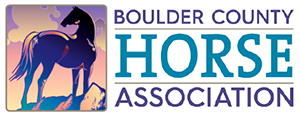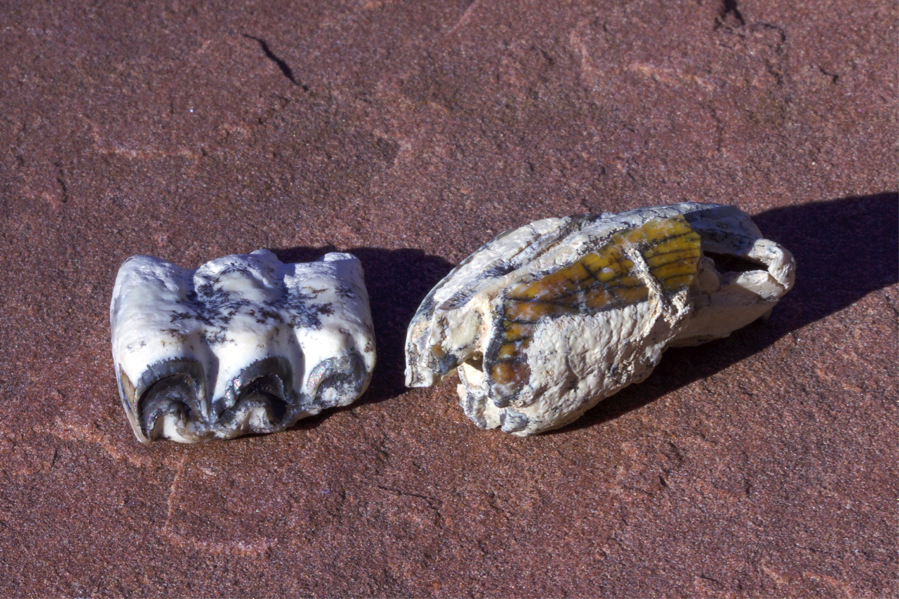Caption: Fossilized horse teeth—a molar and an incisor with some enamel remaining—from approximately 13 million years ago (made you look!)
Serendipity struck while I was doing research on the limber pines at Pawnee Buttes, near the junction of the boundaries of CO, NB and WY. While on a break, I found shade and a soft seat on a pile of sand eroded from a tall cliff. I was sifting the soft sediment with my left hand when my fingers encountered something hard just below the surface. I extracted it and found myself staring at a fossilized tooth, an incisor that retained some of its enamel. A few minutes later I found a molar. These were from an ancestor of modern horses that lived 13 million years ago (mya).
My lucky find of fossil teeth reminded me that horses were native to North America (NA), but their history has some intriguing twists and turns during their migration around the world.
The family Equidae, which includes horses, zebras and asses, evolved in NA during the Eocene Epoch, 54 mya. The genus Equus, including the horse, Equus ferus, evolved during the Pliocene, between 4.5 and 4.0 mya in NA.
During glacial periods, accumulation of ice on land lowered sea level to the point that an enormous expanse of land called Beringia connected current day Siberia and Alaska. Approximately 4 mya horses spread across NA and some populations migrated across Beringia to Asia and then to Europe.
As recently as the Pleistocene Epoch (2.5 mya to 11,700 ya) the family Equidae had five genera, but only one, Equus, survived the extinction of large mammals at the end of the Pleistocene. The genus Equus has numerous extinct species and just five surviving species. Today Equus includes one horse, three zebras, and three asses or donkeys.
A world-wide Megafaunal Extinction, or extinction of big mammals, occurred at end of Pleistocene and in NA camels, dire wolves, short-faced bears, cheetahs, lions, two species of buffalo, giant beavers, giant ground sloths, 13 species of pronghorn, wooly rhinos, mammoths and mastodons went extinct. The direct causes of the extinctions are controversial, but extinctions were coincident with climate change, change in plant communities and the arrival of humans.
The Mahaffy Cache ties this major extinction event to Boulder. Near the lower entrance to Gregory Canyon in Boulder, during construction of a rock garden in 2009, a cache of Clovis cutting stones was found in the yard of Patrick Mahaffy, who promptly shared the discovery with CU Professor Doug Bamforth. They had the cutting implements analyzed for proteins, which revealed that the tools were used to butcher bears, camels and horses 13,000 ya. Ancient skeletal remains of a butchered horse were also discovered in southern Alberta.
Initially, horses were thought to have gone extinct during the Megafaunal Extinction. But horses recently excavated from permafrost in Alaska died as recently as 7,600 ya, marking a much more recent extinction of Equus in NA, the cradle of horse evolution.
Just 2,000 years after the extinction of horses in NA, the horses that had migrated to Asia were being domesticated in Kazakhstan. Studies of teeth and bones indicated that horses were bridled, and residues on fragments of pottery showed that they had contained horse’s milk. The tradition of drinking mare’s milk continues today in Kazakhstan.
On his second trip to the New World, in 1493, Columbus introduced domesticated horses from Europe to Hispaniola and Cuba. In 1519, the Conquistador Hernán Cortés introduced horses to Mexico, and as Conquistadors searched for gold and priests spread the faith, horses occasionally escaped and formed feral populations. Within 100 years horses had returned to the Great Plains. Approximately 7,200 years after their local extinction in NA, horses completed an unlikely trip around the world and were once more running wild in the Great Plains and Great Basin.
Jeff Mitton
Jeff Mitton, mitton@colorado.edu, is a professor in the Department of Ecology and Evolutionary Biology at the University of Colorado
Article in Boulder Daily Camera January 12, 2018 reprinted with permission of the author

